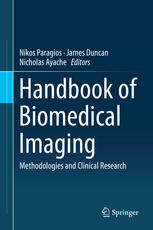کتاب راهنمای تصویربرداری زیست پزشکی: روش شناسی و تحقیقات بالینی ۲۰۱۵
Handbook of Biomedical Imaging: Methodologies and Clinical Research 2015
دانلود کتاب کتاب راهنمای تصویربرداری زیست پزشکی: روش شناسی و تحقیقات بالینی ۲۰۱۵ (Handbook of Biomedical Imaging: Methodologies and Clinical Research 2015) با لینک مستقیم و فرمت pdf (پی دی اف)
| نویسنده |
James Duncan, Nicholas Ayache, Nikos Paragios |
|---|
| تعداد صفحهها |
511 |
|---|---|
| نوع فایل |
|
| حجم |
15 Mb |
| سال انتشار |
2015 |
89,000 تومان
معرفی کتاب کتاب راهنمای تصویربرداری زیست پزشکی: روش شناسی و تحقیقات بالینی ۲۰۱۵
تجزیه و تحلیل تصویر زیست پزشکی به یکی از جنبه های اصلی علم مهندسی تبدیل شده است و رادیولوژی به طور خاص به یک بازیگر غالب در این زمینه تبدیل شده است. پیشرفت های اخیر امکان استفاده از تصویربرداری زیست پزشکی را برای مشاهده بدن انسان از منظر آناتومیکی یا فیزیولوژیکی به روشی غیرتهاجمی فراهم کرده است. تشخیص به کمک رایانه شامل توسعه الگوریتم ها و مؤلفه های نرم افزاری هوشمند است که می توانند به طور خودکار تصاویر را پردازش کرده و بی نظمی های احتمالی در زنجیره سلامت را شناسایی کنند.
هدف این کتاب توضیح فرآیند تصویربرداری زیست پزشکی، از گرفتن تصویر تا تشخیص ابزاری است. این فرآیند از سه حوزه موضوعی تشکیل شده است. اولین مورد به فرآیند اکتساب و ویژگی های اساسی تصاویر از دیدگاه فیزیک گرا اختصاص دارد. بخش دوم به روش های مدرن رایج در پس استخراج محتوا و تفسیر تصاویر پزشکی می پردازد. بخش سوم یک مثال مبتنی بر کاربرد ارائه می کند که راه حل هایی را برای رفع نیازهای خاص تشخیص های مختلف ایجاد می کند.
این جلد کامل ابزاری استثنایی برای رادیولوژیست ها، دانشمندان پژوهشی و دانشجویان ارشد و کارشناسی ارشد در رشته های علوم بهداشتی و مهندسی و اساتید دانشگاه است. این کتاب یک راهنمای منحصر به فرد برای کل طیف تصویربرداری زیست پزشکی ارائه می دهد و توضیح می دهد که چگونه تصویر ساخته می شود و چگونه از مناسب ترین الگوریتم ها برای پاسخگویی به درخواست ها و تشخیص ها استفاده می شود.
Biomedical image analysis has become a major aspect of engineering sciences, and radiology in particular has become a dominant player in the field. Recent developments have made it possible to use biomedical imaging to view the human body from an anatomical or physiological perspective in a non-invasive fashion. Computer-aided diagnosis consists of developing algorithms and intelligent software components that can automatically process images and spot potential irregularities in the health chain.
The aim of this book is to explain the process of biomedical imaging, from image acquisition to automated diagnosis. This process consists of three thematic areas. The first is dedicated to the acquisition process and the underlying properties of images from a physics-oriented perspective. The second part addresses the dominant state-of-the-art methodologies behind content extraction and interpretation of medical images. The third section presents an application-based example, which develops solutions to address the particular needs of various diagnoses.
This complete volume is an exceptional tool for radiologists, research scientists, senior undergraduate and graduate students in health sciences and engineering, and university professors. This book offers a unique guide to the entire chain of biomedical imaging, explaining how image formation is done, and how the most appropriate algorithms are used to address demands and diagnoses.



